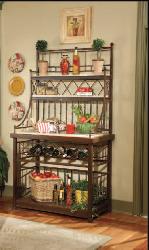bakers rack : Even novice bakers can handle focaccia
Most people think baking bread is difficult. Perhaps they're afraid of working with yeast or think the process is too time-consuming. But you can produce a wonderful, preservative-free loaf in just three hours, with no more than 30 minutes of actual work.
A great place to start is with focaccia. Dense and about an inch and a half high, this Italian bread couldn't be easier. There's very little shaping involved - just a bit of stretching to form the dough into a rectangle. Once that's done, dimple the top, drizzle on olive oil, sprinkle with salt and bake away.
Here are tips to help you tackle any yeast-bread recipe with confidence:
• Bread making begins with combining yeast and warm water. If the water is too hot, it will kill the yeast; if it's too cold, the yeast won't activate. It should be between 105 and 115 degrees. Test it against the inside of your wrist - it should feel comfortably warm, like a baby's bottle.
• Use bread flour (it's unbleached and high-gluten) or unbleached all-purpose flour. Bleached flour has weaker proteins, which can compromise the bread's texture.
• Create a warm, moist, draft-free environment for your dough to rise in by placing it in an unheated oven (regular or microwave) with a cup of hot water. Change the water every 30 minutes.
• Let the dough rise only until it has doubled. Check it by pressing two fingers about ½ inch into the dough. If the indentation remains, the dough is ready to shape.
• Almost any dough can be kneaded with an electric stand mixer equipped with a dough hook.
• Remove bread from the pan as soon as it's baked and let it cool on a rack so the bottom doesn't become soggy. Let it cool until just warm before slicing with a serrated knife.
by CAROLE KOTKIN
A great place to start is with focaccia. Dense and about an inch and a half high, this Italian bread couldn't be easier. There's very little shaping involved - just a bit of stretching to form the dough into a rectangle. Once that's done, dimple the top, drizzle on olive oil, sprinkle with salt and bake away.
Here are tips to help you tackle any yeast-bread recipe with confidence:
• Bread making begins with combining yeast and warm water. If the water is too hot, it will kill the yeast; if it's too cold, the yeast won't activate. It should be between 105 and 115 degrees. Test it against the inside of your wrist - it should feel comfortably warm, like a baby's bottle.
• Use bread flour (it's unbleached and high-gluten) or unbleached all-purpose flour. Bleached flour has weaker proteins, which can compromise the bread's texture.
• Create a warm, moist, draft-free environment for your dough to rise in by placing it in an unheated oven (regular or microwave) with a cup of hot water. Change the water every 30 minutes.
• Let the dough rise only until it has doubled. Check it by pressing two fingers about ½ inch into the dough. If the indentation remains, the dough is ready to shape.
• Almost any dough can be kneaded with an electric stand mixer equipped with a dough hook.
• Remove bread from the pan as soon as it's baked and let it cool on a rack so the bottom doesn't become soggy. Let it cool until just warm before slicing with a serrated knife.
by CAROLE KOTKIN
